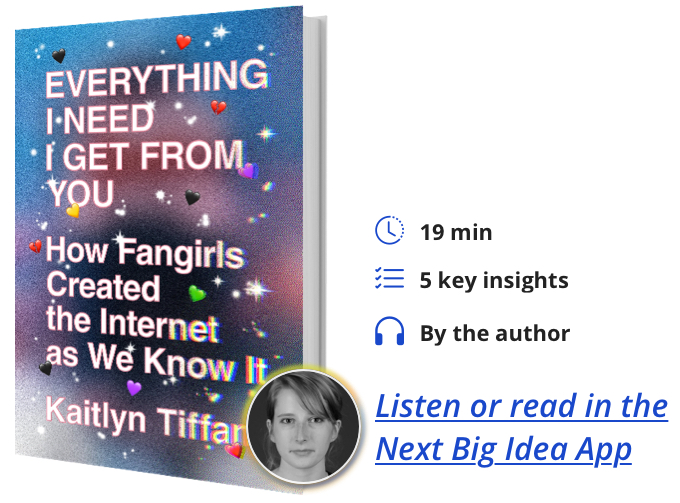Kaitlyn Tiffany is a staff writer at The Atlantic, where she covers technology and culture. She was previously on the same beat at Vox’s consumer vertical The Goods, after starting her career writing about pop culture, fandom, and online community at The Verge.
Below, Kaitlyn shares 5 key insights from her new book, Everything I Need I Get from You: How Fangirls Created the Internet as We Know It. Listen to the audio version—read by Kaitlyn herself—in the Next Big Idea App.

1. It’s impossible to understand social media and the contemporary internet without understanding fandom—and vice versa.
Both fandom and social media have provided structure in people’s lives, but they’ve also produced a certain amount of cultural chaos. They’ve provided meaning to people—positive, generative, and progressive—but sometimes oversupplied it in a way that could be confusing or destructive.
In both the internet and subcultures, a lot of the contributions of women, especially young women, have been overlooked. In both of those fields, the contributions of young men have been a lot more interesting to onlookers, journalists, and cultural observers—potentially because male subcultures tend to be, or have been in the past, more visible or more unsettling, with more of a proclivity toward violence.
I started my career as a reporter during Gamergate, the massive, coordinated harassment campaign led by angry young men online. It transitioned pretty seamlessly into the rising tide of MAGA, the alt-right, the incel movement, and all sorts of scary, boy-centric online subcultures that people thought were dangerous and paid a lot of attention to. At the same time, I was also participating in fandom, and noticing that this really significant cultural phenomenon wasn’t getting as much attention because it wasn’t as scary—but also, maybe people found it embarrassing or inconsequential.
Now is the time to think about how fandom has shaped the way we talk online, the way our online networks are structured, the way we understand culture and politics and our social realities. Fangirls are a big key to that because they are participating in the mainstream, but they’re also participating in a way that is confusing or repellent to others. They’re buying into these really generic cultural products, but they’re also refusing to take them at face value, mutating things and making them their own. They’re loudly and publicly refusing to make their time useful, refusing to participate in the system as it’s set up, but they’re not precisely resistant or revolutionary either. They’re using these social media platforms that profit from them purchasing albums and merch, and they know it, but they are trying to extract their own meaning from that as best they can.
2. The image of the screaming fangirl.
The image of the screaming fangirl is not a lie. Fangirls really did scream for Frank Sinatra, for the Beatles, for the Backstreet Boys, and for One Direction. When I went to One Direction concerts, I would sometimes even get frustrated because the screaming was so persistent that it was hard to hear the band. But a screaming fangirl usually has a lot more to say than just inarticulate screaming. If you ask a screaming fangirl just one follow-up question about her fandom, what she’s doing, and why she’s experiencing so much emotion, almost everybody I spoke to had rich and interesting stories to tell.
“Every generation’s boy band serves a different purpose, but they have this uniting, underlying obligation to open up space for the people who love them in evoking irrational feelings.”
They had kind of bizarre and novel artistic practices. After they got done screaming at the concert, they would go home, write fan fiction, remix whatever photos they took into elaborate GIFs or collages—all kinds of things that could be used as cultural capital in the fandom, or just as a private artistic practice, part of what subcultural experts would call “bedroom culture.” It was the first widely acknowledged subculture that was specific to teenage girls, this practice of retreating into a private part of the home and cutting up magazines, doodling song lyrics, creating a personal experience of popular culture.
As far as why that fangirl is screaming in public, I benefited from reading old coverage of Beatles fangirls. This was just before the women’s movement of the 1970s, so it would’ve made sense for teenage girls to be frustrated and scared, and looking for pockets of opportunity and oxygen within the structures of their lives. This was even acknowledged in the writing—some of the male journalists would kind of make fun of them for this, that they would get this chance to scream, and then have to go back to a domestic, subservient lifestyle.
Every generation’s boy band serves a different purpose, but they have this uniting, underlying obligation to open up space for the people who love them in evoking irrational feelings. They set these girls up for some level of introspection. By providing this unhinged bodily joy, they provide an opportunity to think about why most of your life doesn’t involve that level of joy. While screaming at a pop concert is not revolutionary or resistant, it does provide individual people this opportunity to punctuate the prolonged periods of silence in their lives.
3. Tumblr, the home of all modern internet culture, is eroding and poorly tended to.
Because of Tumblr’s culture, people feel free to leave the platform and delete their blogs, to dismantle whatever they had contributed if they want to start over and participate in a different subculture on the site. There’s a real culture of starting fresh, which makes it hard, years later, to go back and find things that you know were there.
The social internet is constantly eroding, shedding information and cultural history, so fans are the best and only keepers of its history in a deliberate way. When I was looking for key moments from One Direction fandom history, I wasn’t finding them on popular sites like Know Your Meme that claimed to have this exhaustive history of internet culture. I had to find them by going to blogs on Tumblr run by long-term One Direction fans, who prided themselves on having this exhaustive recall.
“The social internet is constantly eroding, shedding information and cultural history, so fans are the best and only keepers of its history in a deliberate way.”
There is one in particular called bad1dimagines, which started as a collection of strange, super-short fan fiction. (Like an image collage, with the overlying text, “the outfit you wear when Niall Horan hits you with his car.”) But the person who runs it remembers every single fandom meme, every single event in the history of the fandom, and people will come to her anonymous ask box and say, “Do you remember why Liam Payne is supposedly afraid of spoons?” She would be able to find relevant links, then represent and re-archive it by answering the question in public on her blog.
I thought that was really fascinating, and reminded me of this 2016 book Rogue Archives by Abigail De Kosnik. She talks about how “traditional memory institutions were not designed to safeguard cultural texts that proliferate indefinitely.” Rather, fans and other kinds of amateur archivists have to engage in continual conversations of “remember when?” in order to preserve cultural memory. Part of today’s fan culture is doing that—rehashing fan culture in order to preserve fan culture.
4. Modern fandom is susceptible to conspiracy thinking.
In 2015 and 2016, One Direction fandom conspiracy theories bubbled up. They were quite complex, but they basically had to do with two members of the band being secretly in love and secretly married. For one of them, who has a son with a former girlfriend, the conspiracy theory claims that that child is not really his. This produced all kinds of chaos and conflict within the fandom.
The way these conspiracy theories took hold is strikingly similar to the way that we talk about misinformation and disinformation, and pulling people into conspiracy theories in other contexts. Believers in these One Direction conspiracy theories would often circulate images or videos that they said were “proof” of their theory, which were usually blurry and hard to make out. If there was audio in a video, you wouldn’t be able to understand what it was saying—but whoever was distributing it would provide captions that would (allegedly) tell you what it was saying. If you were provided with that context, and you trusted the person who was providing it, then sure, maybe that’s what it sounds like the audio is saying.
“The way these conspiracy theories took hold is strikingly similar to the way that we talk about misinformation and disinformation.”
If you think Louis and Harry are in love, you go to a concert, film the whole thing, and then cut up GIFs showing what seems to be them looking into each other’s eyes meaningfully from across the stage. You’re selecting these images from a plethora of images, and then deliberately editing and crafting them to create a certain impression. Looking back on this community as a journalist, I realized, “Oh, this is exactly how I’ve seen people present all kinds of conspiracy theories online.”
5. Fandom has political potential that journalists don’t yet fully understand.
Fandom is not inherently political, but it is a way of organizing and mobilizing people, especially online—which is pretty similar to the way we think about modern political activity. People noticed this during the Black Lives Matter movement as far back as 2017, when Harry Styles’ fans were lobbying him to participate, and then more recently in the summer of 2020, when K-pop fans were mobilizing around Black Lives Matter by crashing police apps and spamming different tags. There was a lot of conversation about, “Gen-Z fans are politically motivated. They’re progressive. They’re going to save the world!” In those instances, the fans were progressive, and it was inspiring and exciting to watch. But the tools of fandom that are politically useful are basically spamming and media manipulation, which could be used in a variety of ways—and has been.
Fans are always fighting behind the scenes over the political meaning of their idols, which we saw when Nicki Minaj fans were torn up about her vaccine hesitancy and her promotion of a Tucker Carlson clip. Some really dug in, defended her, and started espousing similar opinions, whereas others were disappointed with her and bickered about how to recalibrate her positions. I think we have yet to see the diversity and range of outcomes that can come from fans picking up and wielding political power on the internet. I’ll be really fascinated to see what happens going forward.
To listen to the audio version read by author Kaitlyn Tiffany, download the Next Big Idea App today:































